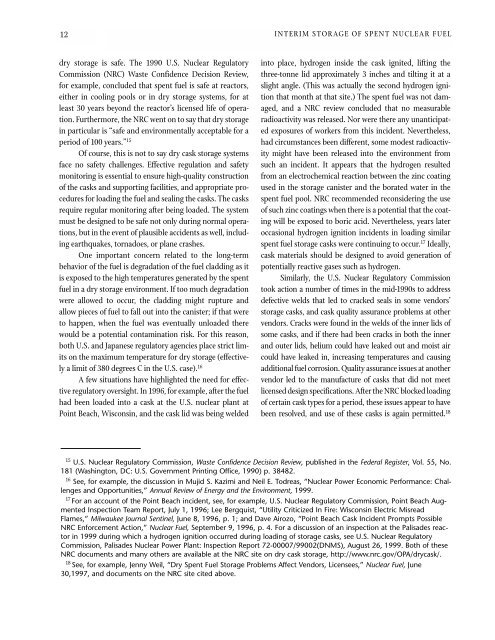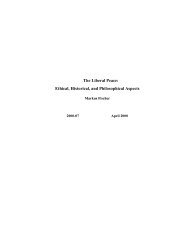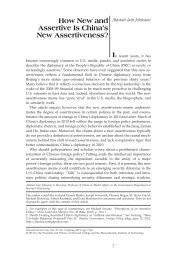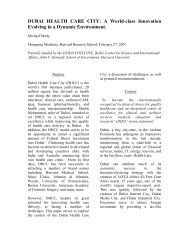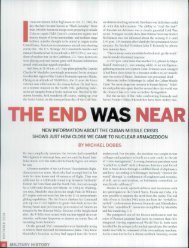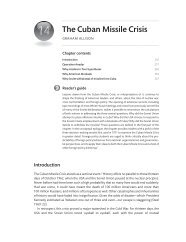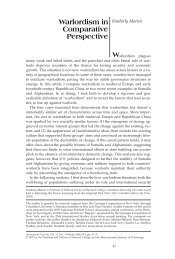Interim Storage of Spent Nuclear Fuel - Woods Hole Research Center
Interim Storage of Spent Nuclear Fuel - Woods Hole Research Center
Interim Storage of Spent Nuclear Fuel - Woods Hole Research Center
You also want an ePaper? Increase the reach of your titles
YUMPU automatically turns print PDFs into web optimized ePapers that Google loves.
12<br />
dry storage is safe. The 1990 U.S. <strong>Nuclear</strong> Regulatory<br />
Commission (NRC) Waste Confidence Decision Review,<br />
for example, concluded that spent fuel is safe at reactors,<br />
either in cooling pools or in dry storage systems, for at<br />
least 30 years beyond the reactor’s licensed life <strong>of</strong> operation.<br />
Furthermore, the NRC went on to say that dry storage<br />
in particular is “safe and environmentally acceptable for a<br />
period <strong>of</strong> 100 years.” 15<br />
Of course, this is not to say dry cask storage systems<br />
face no safety challenges. Effective regulation and safety<br />
monitoring is essential to ensure high-quality construction<br />
<strong>of</strong> the casks and supporting facilities, and appropriate procedures<br />
for loading the fuel and sealing the casks. The casks<br />
require regular monitoring after being loaded. The system<br />
must be designed to be safe not only during normal operations,<br />
but in the event <strong>of</strong> plausible accidents as well, including<br />
earthquakes, tornadoes, or plane crashes.<br />
One important concern related to the long-term<br />
behavior <strong>of</strong> the fuel is degradation <strong>of</strong> the fuel cladding as it<br />
is exposed to the high temperatures generated by the spent<br />
fuel in a dry storage environment. If too much degradation<br />
were allowed to occur, the cladding might rupture and<br />
allow pieces <strong>of</strong> fuel to fall out into the canister; if that were<br />
to happen, when the fuel was eventually unloaded there<br />
would be a potential contamination risk. For this reason,<br />
both U.S. and Japanese regulatory agencies place strict limits<br />
on the maximum temperature for dry storage (effectively<br />
a limit <strong>of</strong> 380 degrees C in the U.S. case). 16<br />
A few situations have highlighted the need for effective<br />
regulatory oversight. In 1996, for example, after the fuel<br />
had been loaded into a cask at the U.S. nuclear plant at<br />
Point Beach, Wisconsin, and the cask lid was being welded<br />
INTERIM STORAGE OF SPENT NUCLEAR FUEL<br />
into place, hydrogen inside the cask ignited, lifting the<br />
three-tonne lid approximately 3 inches and tilting it at a<br />
slight angle. (This was actually the second hydrogen ignition<br />
that month at that site.) The spent fuel was not damaged,<br />
and a NRC review concluded that no measurable<br />
radioactivity was released. Nor were there any unanticipated<br />
exposures <strong>of</strong> workers from this incident. Nevertheless,<br />
had circumstances been different, some modest radioactivity<br />
might have been released into the environment from<br />
such an incident. It appears that the hydrogen resulted<br />
from an electrochemical reaction between the zinc coating<br />
used in the storage canister and the borated water in the<br />
spent fuel pool. NRC recommended reconsidering the use<br />
<strong>of</strong> such zinc coatings when there is a potential that the coating<br />
will be exposed to boric acid. Nevertheless, years later<br />
occasional hydrogen ignition incidents in loading similar<br />
spent fuel storage casks were continuing to occur. 17 Ideally,<br />
cask materials should be designed to avoid generation <strong>of</strong><br />
potentially reactive gases such as hydrogen.<br />
Similarly, the U.S. <strong>Nuclear</strong> Regulatory Commission<br />
took action a number <strong>of</strong> times in the mid-1990s to address<br />
defective welds that led to cracked seals in some vendors’<br />
storage casks, and cask quality assurance problems at other<br />
vendors. Cracks were found in the welds <strong>of</strong> the inner lids <strong>of</strong><br />
some casks, and if there had been cracks in both the inner<br />
and outer lids, helium could have leaked out and moist air<br />
could have leaked in, increasing temperatures and causing<br />
additional fuel corrosion. Quality assurance issues at another<br />
vendor led to the manufacture <strong>of</strong> casks that did not meet<br />
licensed design specifications. After the NRC blocked loading<br />
<strong>of</strong> certain cask types for a period, these issues appear to have<br />
been resolved, and use <strong>of</strong> these casks is again permitted. 18<br />
15 U.S. <strong>Nuclear</strong> Regulatory Commission, Waste Confidence Decision Review, published in the Federal Register, Vol. 55, No.<br />
181 (Washington, DC: U.S. Government Printing Office, 1990) p. 38482.<br />
16 See, for example, the discussion in Mujid S. Kazimi and Neil E. Todreas, “<strong>Nuclear</strong> Power Economic Performance: Challenges<br />
and Opportunities,” Annual Review <strong>of</strong> Energy and the Environment, 1999.<br />
17 For an account <strong>of</strong> the Point Beach incident, see, for example, U.S. <strong>Nuclear</strong> Regulatory Commission, Point Beach Augmented<br />
Inspection Team Report, July 1, 1996; Lee Bergquist, “Utility Criticized In Fire: Wisconsin Electric Misread<br />
Flames,” Milwaukee Journal Sentinel, June 8, 1996, p. 1; and Dave Airozo, “Point Beach Cask Incident Prompts Possible<br />
NRC Enforcement Action,” <strong>Nuclear</strong> <strong>Fuel</strong>, September 9, 1996, p. 4. For a discussion <strong>of</strong> an inspection at the Palisades reactor<br />
in 1999 during which a hydrogen ignition occurred during loading <strong>of</strong> storage casks, see U.S. <strong>Nuclear</strong> Regulatory<br />
Commission, Palisades <strong>Nuclear</strong> Power Plant: Inspection Report 72-00007/99002(DNMS), August 26, 1999. Both <strong>of</strong> these<br />
NRC documents and many others are available at the NRC site on dry cask storage, http://www.nrc.gov/OPA/drycask/.<br />
18 See, for example, Jenny Weil, “Dry <strong>Spent</strong> <strong>Fuel</strong> <strong>Storage</strong> Problems Affect Vendors, Licensees,” <strong>Nuclear</strong> <strong>Fuel</strong>, June<br />
30,1997, and documents on the NRC site cited above.


